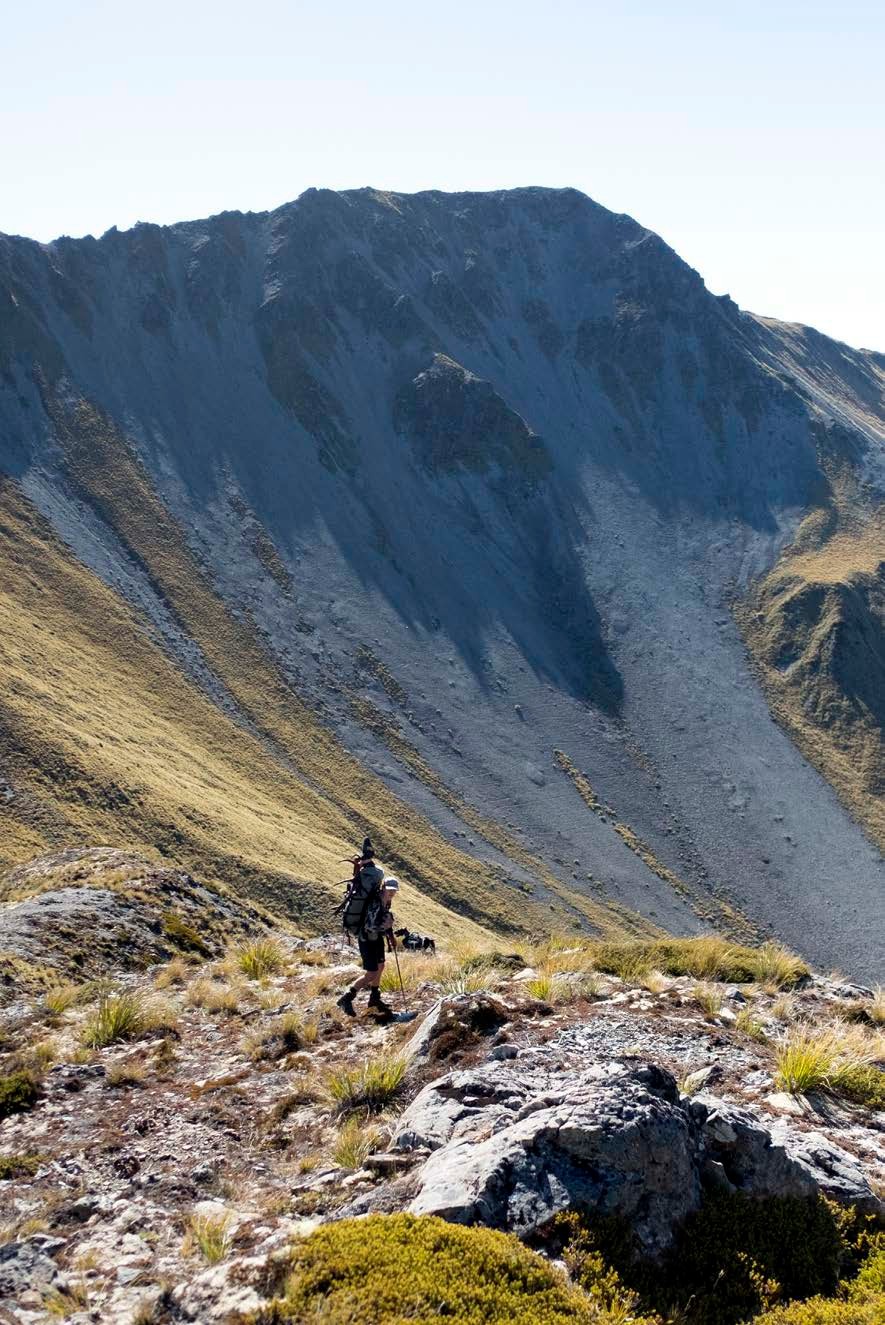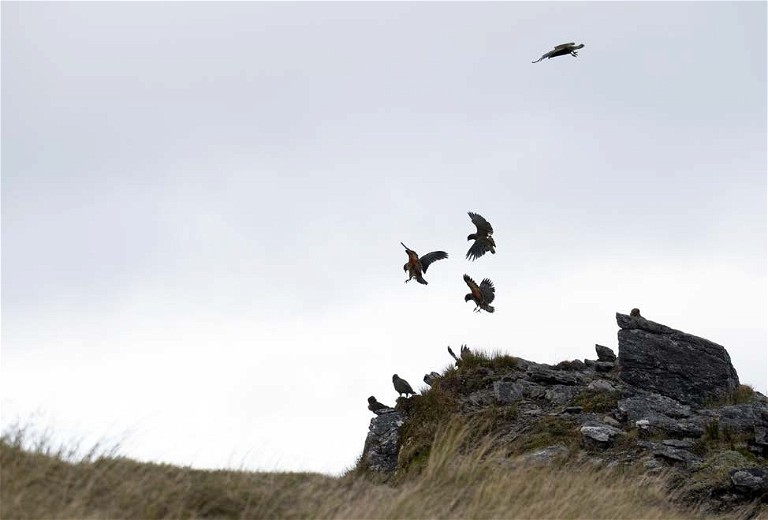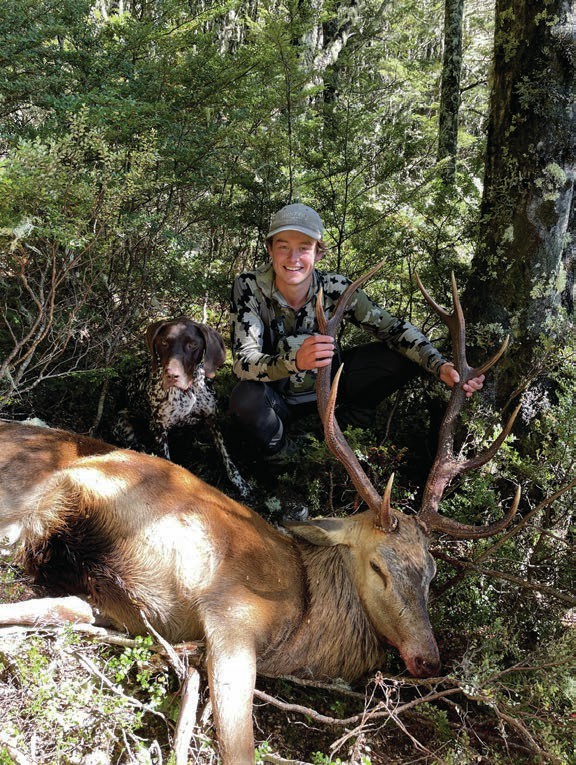Stag & Chamois
Words & Images by Tim Schulpen

W henit comes to hunting in New Zealand, there’s always something to look forward to. From the end of March through April, and sometimes even into May, our deer species have their mating seasons all around the country, and I usually find myself chasing the all-consuming roar.
For the remainder of the year, chasing Tahr and chamois is another option, as their rut takes place during the winter and they become even more accessible in the spring. Once that’s all over, long summer days allow for easy travel over alpine passes and you can witness animal numbers that you never would have believed in winter.
With some planning and accumulated leave, you can follow these short-lived windows, bouncing your way up and down the country. You can try hunting reds in the Canterbury high country in early April, and then quickly race up to the central North Island to chase sika. Despite the possibilities and excitement of brainstorming, I always end up panicking at the end of March, trying to decide where to go, what to hunt, and whether the boss will approve my leave.
Last year was no different. I finally got together with my buddy Jae to make the final call on where to go for our roar trip. It was 1:00 am, our trip was about to start, and our destination had yet to be decided. We had the entire South Island to pick from, but despite hearing plenty of tales about ‘wall-hanger’ reds being pulled out of the Otago area, we kept being drawn back to the Arthur’s Pass catchment. Jae was obviously getting sick of my indecisiveness and finally made the call. “It’s always good once you’re in there,” he said, pointing at the ridge on the centre of the laptop screen. An extremely wise and valid point from a kid born in the early 2000s.
There was, and still is, a diverse set of opinions on the Arthur’s Pass area. Great heads seem to be produced there; not only for red stags but also for chammy bucks. However, the regular poisoning through the majority of the National Park seems to weigh heavily on people’s minds and means the area is considered less productive than it really is. There can be low numbers of deer in some areas of Arthur’s Pass, and people are quick to conclude that this means poor hunting for the entire area. Putting the negatives aside, we allocated five days to see what we could find, with the ultimate goal of finding one nice stag and a first chammy buck for Jae. We both thought this was more than achievable, particularly given the absence of snow and a range that provided plenty of travel scope into distant basins.

Chamois are high on the bucket list for most kiwi hunter’s, especially a specimen like this.
There was an immediate roar as we parked the ute – anice omen to start the trip – that offered us a brief distraction from the impending slog up to the main ridge. It was a bluebird day, which allowed us to see for miles in the direction we were heading, but the heat, 12km of alpine travel, and 1100 vertical metres quickly took a toll on both of us. Night one came around mercifully after a long day on the feet. We found ourselves perched above two large basins, hearing roars far below us, deep in the bush. A lone chamois in the bluffs poked his head out just as the sun faded, the only animal we saw that day.
As we began day two – the second slog of the trip – the whistle of a chamois had us very rapidly dropping our packs and reaching for the binos. Although it sounded extremely close, we couldn’t locate it to save ourselves. Long story short, this was the most excitement we would get for another day as we pushed on without seeing a single deer.
On day three, we changed tactics to bush hunting and our luck changed. We decided that all the stags were holding tight in the shade of the trees and had likely pushed the hinds out of the tops with them. One bush basin had at least four stags roaring well, so we punched down a long spur and hunted, 40 metres below the bush edge, back up the valley towards camp. With the thermals pushing up from the valley floor, the idea for this approach was that we would see anything that might be just above us, while not going too deep and cutting animals off. Although everything went quiet for a moment once we stepped foot in the bush, the deer quickly piped up again when we let off an aggressive, challenging roar.

The search never ends once you’ve got the bug.
“ It was a bluebird day, which allowed us to see for miles...but the heat, 12km of alpine travel, and 1100 vertical metres quickly took a toll on both of us. ”

Kea: otherwise known as Aotearoa’s prettiest criminals.

Hooks like Jupiter.
Two stags started going at it in the spot we had just walked through. As we continued to roar, it sounded like one was being drawn in closer to us. Jae suddenly tapped me on the shoulder and pointed at another stag sneaking around us through some beech. He was likely trying to get on our uphill side and into our scent. I took Jae’s word when he said, “It’s a good stag!” and placed a round in his chest at around 25 metres, sending him tumbling down the hill. In the moment, I could tell he had goodlength antlers but wasn’t sure of his shape because he was broadside to us with his head facing forwards.

Sometimes It’s the simple things. Camp food done right (and light) with Radix freeze-dried meals.

Camping up top: it’s usually better if it’s not raining sideways.
As we scrambled down the hill, we quickly realised his top inner tines almost touched, and he was easily the narrowest stag Jae and I had ever seen. Despite this, the antlers boasted a dark maroon colour unlike any tussock or alpine stag I had shot to date. He measured up to be a respectable 37” in length. Quick work was made of the butchering before we made our way back to camp for lunch. After a few hours lounging in the sun early in the afternoon, we decided to look for another stag in the next basin rather than try for a first buck chamois for Jae. With this being the last chance for a stag, we packed all the gear required for a walk back to camp in the dark. We didn’t make it ten minutes into our tramp before spotting a lone chamois on the bush line below us. Both of us were extremely surprised to see one that low. I wasn’t convinced it was a big buck as it seemed to lack a bit in the hook, but Jae was excited to have a crack anyway. Being above them while making an assessment in the spotting scope can often make them seem a lot smaller than they are. Holding on his shoulder for a relatively long shot with the .308, Jae let a round go.
The chamois quickly disappeared down a small chute, and then reappeared on a scree face another 30 metres away. The shot looked like a good hit, and the sight of him beginning his tumble a few seconds later confirmed Jae had got himself his first buck. I quickly apologised to Jae as we walked up to the amimal as I had completely misjudged his length – it was far better than I initially thought. Running the tape over the hooks, he was a hair shy of 9.5” and had a fair few age rings stacked up at the base; an impressive first chamois and a hard candidate to improve on.

The Southern Alps are an adult playground for those willing to pay the sweat tax.

“ A cold beer stashed in the tray was more than deserved. ”
With all our goals well and truly knocked out of the park, we decided on a leisurely evening sorting gear and eating rations, before walking out a day early. The last day consisted of steep descents, sore knees, and another stinking hot day for a long traverse along the tops. A cold beer stashed in the tray was more than deserved as we returned to the Ute late that afternoon. Not a bad trip considering it was all based on 1:00 am decision-making!